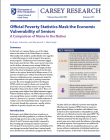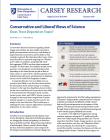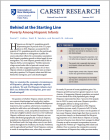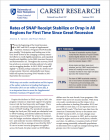Publications

November 17, 2015
This brief documents the proportion of Americans who would have been poor absent the Earned Income Tax Credit (EITC), all else being equal, across 2010–2014. We examine Supplemental Poverty Measure (SPM) rates as well as hypothetical increases in the rates of SPM poverty in the absence of federal EITC benefits. It is important to note that we do not model behavioral changes that might result from...

October 22, 2015
U.S. media and popular culture historically portrayed drug abuse as an urban problem, but in recent years, there has been more media attention on rural drug issues. Part of this growing attention pertains to the growing epidemic of narcotic painkiller abuse in rural America. Although all areas of the country experienced increases in painkiller prescribing, abuse, and mortality over the past two...

October 19, 2015
Scaling U.S. Community Investing: The Investor-Product Interface, an in-depth landscape study of the U.S. Community Investing (USCI) field. The full report includes a detailed analysis of the major types of USCI products, parameters that different investors use to evaluate investment opportunities, and the barriers and opportunities to increasing investment.

October 5, 2015
During the week of September 17–23, a WMUR/CNN poll by the UNH Survey Center1 asked more than 700 New Hampshire residents who they would vote for, given hypothetical pairs of candidates. For example,
Suppose the 2016 presidential election was being held today and the candidates were Donald Trump, the Republican, and Bernie Sanders, the Democrat, who would you vote for?
Other pairings in the...

September 18, 2015
Poverty data from the American Community Survey were released on September 17, 2015, allowing a detailed examination of poverty in 2014 across the United States. These data reveal that child poverty has fallen slightly in the last year yet the longer term pattern of high child poverty persists. The levels of child poverty vary enormously along racial and ethnic lines though all groups have seen a...

September 15, 2015
In this brief, we compare Maine, one of the oldest states in the nation, to the United States as a whole. Historically, both children and the elderly were regarded as vulnerable groups in need of support from government programs. Traditional poverty estimates suggest that at least since the late 1960s, senior poverty has been on the decline, whereas poverty among children has increased. Declines...

September 1, 2015
Conservative distrust of scientists regarding climate change and evolution has been widely expressed in public pronouncements and surveys, contributing to impressions that conservatives are less likely to trust scientists in general. But what about other topics, where some liberals have expressed misgivings too? Nuclear power safety, vaccinations, and genetically modified organisms (GMOs) are...

August 12, 2015
Hispanics are driving U.S. population growth. Representing just 16 percent of the U.S. population in 2010, Hispanics accounted for the majority of U.S. population growth over the past decade. The current emphasis on immigration in public discourse and policy reflects the commonplace assumption that Hispanic population growth is driven largely by new immigration. Yet, most Hispanic growth today is...

August 5, 2015
Political commentators routinely treat rural America as an undifferentiated bastion of strength for Republicans. In fact, rural America is a deceptively simple term describing a diverse collection of places encompassing nearly 75 percent of the U.S. land area and 50 million people. Voting trends in this vast area are far from monolithic. Republican presidential candidates have generally done well...

July 28, 2015
From the beginning of the Great Recession in 2007 until 2012, receipt of Supplemental Nutrition Assistance Program (SNAP) benefits grew steadily.1 Participation and funding rose to historic levels2 driven by the changing economy, intensified efforts to enroll eligible populations, and expanded benefits and eligibility via the 2009 American Recovery and Reinvestment Act. Throughout the recovery,...
